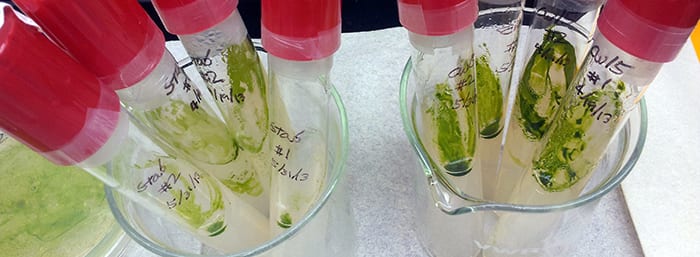Mechanisms of Gram-Positive Microbial Pathogenesis
The host-cell attachment by Gram-positive pathogens, such as Staphylococcus aureus, Enterococcus faecalis, and Streptococcus pneumoniae are essential for understanding the mechanisms of microbial pathogenesis. In S. aureus, wall teichoic acid (WTA), a ribitol-phosphate polymer of cell wall, mediates the host binding. In E. faecalis and S. pneumoniae, pili are used to target the host extracellular matrices. Stable isotopes (13C, 15N, and 19F) are used to selectively label the extracellular matrices of bacteria and epithelial tissues. REDOR NMR is used to measure the heteronuclear dipolar coupling, hence internuclear distances between 19F-13C and 19F-15N to determine the mechanisms of bacterial attachment to host tissues. We also investigate the mechanisms biofilm formation by the Gram-positive pathogens for the prevention and treatment of urinary-tract infections, catheter infections, implant-associated osteomyelitis, and endocarditis. Biofilm-associated infections exhibit increased drug resistance and are difficult to eradicate, resulting in persistent infections.
Carbon flux analysis of lipid body formation in Chlamydomonas reinhardtii

Carbon and nitrogen fluxes in soil green algaChlamydomonas reinharditii during nutrient stress is investigated to gain insight into algal-lipid biosynthesis. Enhanced lipid body (LB) formation (30- to 60-fold) is observed in C. reinhardtii strains cw15 (cell wall-deficient) and cw15sta6 (cell wall- and starch-deficient) when cells are nitrogen (N) starved in the presence of 20 mM acetate, conditions that repress CO2 fixation. We investigated the dynamics of N-stress-induced LB formation in C. reinhardtii by measuring changes in carbon and nitrogen fluxes during N-replete and N-starved conditions using solid-state NMR. Stable-isotope pulse-chase labeling strategies are used to determine 13C- and 15N-isotopic enrichments which corresponds directly to exogenous carbon and nitrogen utilization in intact-whole cells and in purified organelles of C. reinhardtii.
Cyclic Antimicrobial peptides
Cyclic antimicrobial peptides (CAPs) represent vast number of natural products including daptomycin, friulimicin, amphomycin, plusbacin, tripropeptin, ramoplanin, and manopeptimycin, that exhibit potent bactericidal activities against clinically relevant multiple-antibiotic resistant pathogens. We are interested in investigating the mechanisms of CAPs and characterizing its binding site using solid-state NMR.
Differential carbohydrate utilization in insects
Culex pipiens is the mosquito that vectors West Nile Virus and other human-pathogenic flavivruses in North America. In response to shortened day length and lower temperatures, female Cx. pipiense prepares for the diapause by actively feeding on carbohydrates to increase the biosynthesis of glycogen and lipid to store energy for overwintering. The effect of feeding different carbohydrates on glycogen and lipid biosynthesis in diapausing mosquitoes was investigated in vivo using 13C solid-state NMR. Diapause-destined adult females and nondiapausing counterparts after adult eclosion were fed with three different carbohydrate sources for 7 days: 1) 10% sucrose, 2) 10% D-[13C6]glucose, and 3) 1% D-[13C6]glucose co-provisioned with 10% sucrose. NMR measurements show that sucrose and glucose are metabolized differently in diapausing mosquitoes. Mosquitoes fed on sucrose primarily accumulate glycogen with increased branching structures, but less of lipids. In contrast, mosquitoes fed exclusively on glucose show accumulation of both glycogen and lipid with increased aliphatic chain length. Glucose is exclusively metabolized for the biosynthesis of triacylglyceride when mosquitoes were co-fed with sucrose. Our findings provide novel insights into the insect carbohydrate metabolism that governs glycogen and lipid biosynthesis during diapause, which is fundamental for the insect survival during inimical environments.


